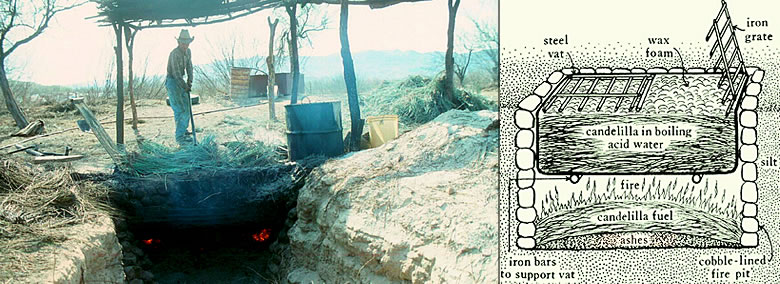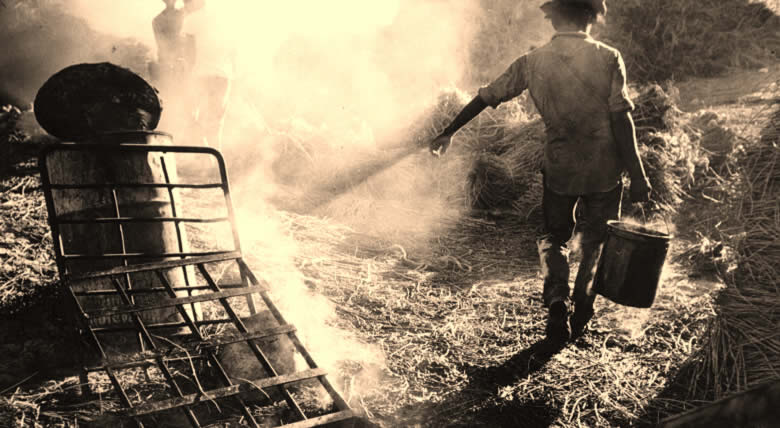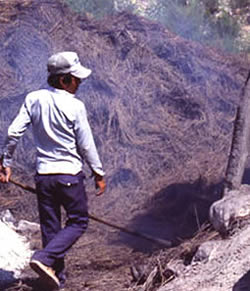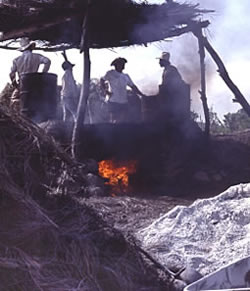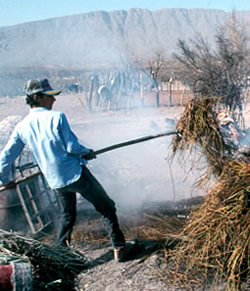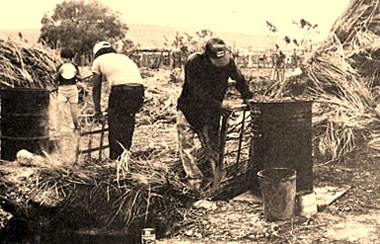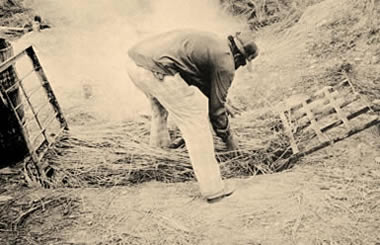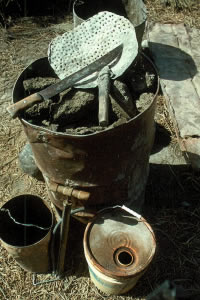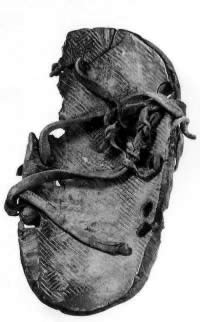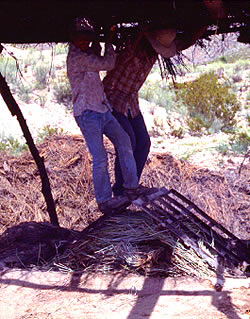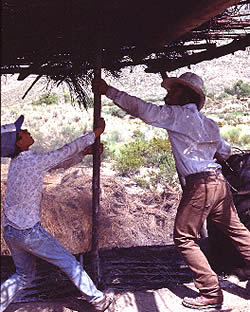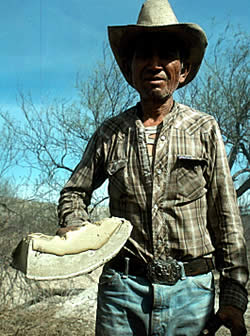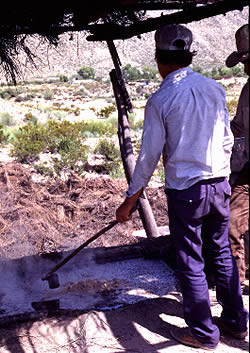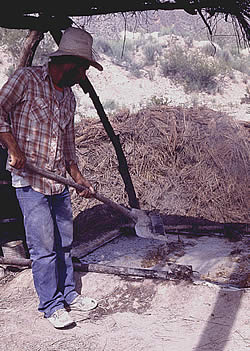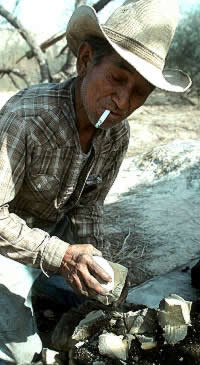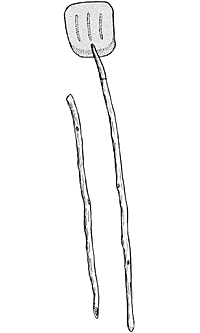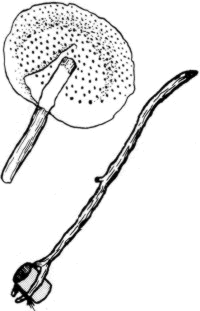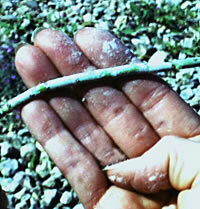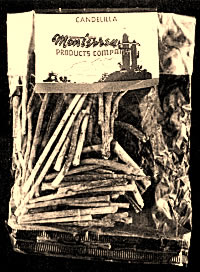
Candelilla, commonly known as "yerba"
or the "weed," is sold as a medicinal tea in some Mexican
herb shops. Reportedly, juice from the plant also was
used as a remedy for venereal disease, hence the name
"Euphorbia antisyphilitica." Photo by Curtis Tunnell.
|
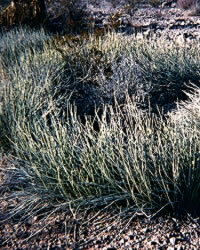
The plant thrives on rocky limestone
slopes, producing clusters up to 6 feet in diameter.
At that size, they often die down in the center leaving
a doughnut-shaped ring of candelilla. Photo by JoAnn
Pospisil. Click to enlarge.
|
|
Experiments in cultivating candelilla for wax production
have been unsuccessful. In one attempt, the land was
prepared and the candelilla was planted and "grew
like weeds," but when the enthusiastic entrepreneurs
began harvesting, they found the plants produced almost
no wax.
|

Carnauba wax, derived from the fronds
of the carnauba wax palm tree (Copernica prunifera)
of Brazil, is the hardest natural wax available and
is very heat resistant. The wax is sold in chips or
flakes, as shown at bottom. Historically, there has
been a greater demand for this wax than candelilla.
|

Like the hardy candelilla—which
can withstand long periods of drought and high temperatures
by thickening its waxy coating—lechuguilla plants
also are desert survivors with specific adaptation techniques.
Threatened by lack of moisture, this plant has shriveled
to minimize surface exposure but will fill out again
when rains come. Photo by Steve Black.
|
|
Various attempts to harvest candelilla with mowing
machines and bulldozers have failed. It seems that two
strong hands, a bent back, and a burro are still the
best way to gather the plant economically.
|

After plants are harvested, the plants
are carefully stacked into bundles of about 50 to 80
pounds each, tied together with a rope, and cinched
tightly with a wooden "honda." Photo by JoAnn Pospisil.
|
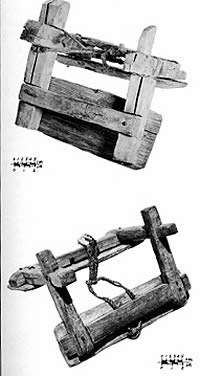
"Fustes" (packsaddles)
like these, when placed on a burro, will support four
bundles of weeds or two bags of wax. Photo by Curtis
Tunnell.
|
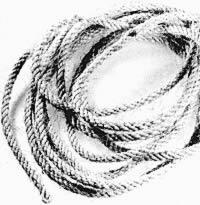
Rope, or "mecate," made of lechuguilla
fiber, used to tie bundles of candelilla. Photo by Curtis
Tunnell.
|
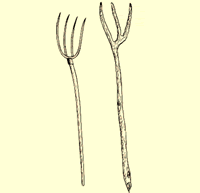
Pitchforks are used to lift plant
stalks into the vat. The handmade version, carved from
a mesquite branch, is far more common in the camps than
the manufactured tool (shown on left). Drawing by Curtis
Tunnell. Click to enlarge.
|
|
The Candelilla Plant
Candelilla is known as the "weed"
to those who work with wax in west Texas, while the Mexican
laborers simply call it "yerba." The botanist J.G.
Zuccarini first described the plant for the scientific world
in 1829 and assigned it the name Euphorbia antisyphilitica.
It is curious that he did not discuss the plant's wax but
did mention juice from the plant being used by the indigenous
peoples as a remedy against venereal disease. Some Mexican
herb shops still carry candelilla as a medicinal tea.
In 1909, G. Alcocer presented a new description
of candelilla, named it Euphorbia cerifera, and discussed
the fine wax produced by the plant. Alcocer's species is considered
synonymous with Euphorbia antisyphilitica Zucc. and
is the primary species of the plant utilized in wax production.
Other minor species also occur in the Chihuahuan Desert. The
common name candelilla probably was applied to the plant because
of its small, erect, wax-coated stems, which resemble little
candles.
Candelilla is a perennial and is found in locally
abundant stands in Mexico in northern Zacatecas, western Nuevo
Leon, eastern Durango, and scattered throughout Coahuila and
Chihuahua, and in Texas in El Paso, Hudspeth, Presidio, Jeff
Davis, Brewster, Terrell, and western Val Verde counties.
Small, isolated populations have been reported in southern
Texas and the Mexican states of Guanajuato and Hidalgo.
The plant commonly grows on well-drained limestone
slopes but is occasionally found associated with igneous rocks,
and it does not seem to grow well in bottomlands and clayey
soils. The root system is small but each plant supports numerous
erect stems, which are mostly simple but occasionally are
branched. A plant of moderate size may produce as many as
100 stems and be, in aggregate, from 1 to 2.5 feet in diameter.
The stems range from about 1 to 2 feet in length and 1/16
to 1/3 of an inch in diameter and are grayish green in color.
In the wax camps we have occasionally observed an unusually
large plant with stems at least 3 feet in length.
Where candelilla has a chance to grow normally,
the plant clusters get larger and larger until they may be
as much as 61/2 feet in diameter. When they get that large
they begin to die down in the center and leave a doughnut-shaped
ring of candelilla. Near McKinney Springs in 1980 we found
plant clusters of this shape that had rabbit nests in the
center of the ring. Detailed botanical descriptions of the
plant can be found in Trees, Shrubs, and Woody Vines of
the Southwest by Robert Vines and in Manual of the
Vascular Plants of Texas by D.S. Correll and M.C. Johnston.
The candelilla plant has been observed flowering
from April through August, apparently coinciding with spring
and summer rains. Stands of the plant seem to be most abundant
at elevations around 2,500 feet and are commonly associated
with lechuguilla, sotol, chinograss, ocotillo, and various
cacti. Severe freezes at higher elevations are said to kill
the plants back to their roots. Candelilla is generally a
very hardy species and not particularly susceptible to diseases
or pests. It does serve as occasional forage for goats and
rabbits. Texas A&M palynologist Vaughn Bryant says candelilla
produces small amounts of pollen, which is sticky and tends
to fall directly to the ground. Candelilla pollen is unlikely
to be widespread or abundant and probably is rare in the archeological
record.
The wax of the candelilla is an epidermal secretion
on the stems that helps conserve internal moisture of the
plants during severe hot and dry periods. The wax, which forms
a scurfy coating on the stems, is much heavier in the dry
season of the year and during periods of drought. Since average
annual rainfall in the desert where candelilla flourishes
ranges from about 4 to 20 inches, drought is not an uncommon
condition. The moisture-protecting mechanism of the plant
is apparently effective for, as Big Bend writer Virginia Madison
has said, "You seldom see a dead candelilla plant."
The summer of 1980 was unusually hot and dry
and many desert plant species such as lechuguilla and Spanish
dagger suffered from desiccation, while candelilla seemed
to suffer very little damage. Plants can be dug up and kept
for long periods of time, and, even after the stems have become
longitudinally wrinkled, the plant will recover when replanted
in the soil. When cut or broken, the stems "bleed"
a white, milky substance, and, if the plants are harvested
by cutting, the root systems will die.
According to a 1953 study by botanists W.H.
Hodge and H.H. Sineath, candelilla is the second most important
vegetable wax after carnauba, which is extracted from a Brazilian
palm. About ten tons of the plant can be harvested per acre
where it grows abundantly, far less in most harvest areas.
Since primitive wax-extraction methods produce a yield of
only about 2 percent of plant weight, the refiner who marketed
one million pounds of wax in a good year was representing
exploitation of about 50 million pounds of wild plants from
2,500 to 5,000 acres of desert. Five or ten times that much
wax may be imported annually from Mexico, representing denuding
of perhaps as much as 50,000 acres of desert of candelilla
growth. Can any desert species survive this magnitude of exploitation?
Apparently candelilla has done fairly well, because wax production
continues after seventy years.
The plants need from two to five years of growth
before they produce significant wax. When we asked many informants
familiar with wax making and marketing how long it took for
candelilla growth to return in an area that has been intensively
harvested, the estimates ranged from five years to fifty years.
All of these estimates may be accurate for different areas
and conditions. Wax refiner David Adams was more specific
and said that after a first harvesting the candelilla will
return in some abundance in two years; after a second harvesting
it takes about five years for candelilla to come back; and
after a third harvesting it might take ten years for there
to be enough plants for economical harvesting. He said in
some areas of northern Mexico they have depleted the candelilla
through overexploitation and are now using pickaxes to pull
out lechuguilla and greasewood in order to get the small amount
of candelilla growing around those plants. In normal harvesting
they would pull out the candelilla that is easy to recover
and leave plants in and around lechuguilla to help the stand
grow back.
In recent years the hearty plant has been transported
widely as an ornamental, and it is reported to grow more robustly
than in the native habitat but to produce little or no wax
under protected conditions. Cultivation of candelilla for
wax production has been attempted in Haiti, Cuba, and the
Dominican Republic but these efforts have failed. A local
informant said he was involved in an expensive experiment
to grow candelilla near Laredo, Texas. The land was prepared
and the candelilla was planted and "grew like weeds,"
but when the enthusiastic entrepreneurs began harvesting,
they found the plants produced almost no wax. Other attempts
at cultivation and mechanical harvesting of candelilla in
the Presidio area were equally unsuccessful. Harvesting native
stands of the plant and processing the wax under primitive
conditions remains the best and perhaps only method of extracting
candelilla wax.
Despite the failure of cultivation efforts and
continued exploitation of the wild plant, candelilla probably
will not be threatened with extinction. Some plants will grow
back from remnant root fragments, and others grow in inaccessible
niches where gathering is impractical. However, some scientists
fear that, after harvesting, candelilla may never return to
its original abundance and balance in the vegetation community.
The impact of the weed harvesting on the desert environment
in general and on associated sensitive plant communities in
particular is a matter of concern to biologists in the Chihuahuan
Desert.
Harvesting the Plant
Various attempts to harvest candelilla with
mowing machines and bulldozers have failed. It seems that
two strong hands, a bent back, and a burro are still the best
way to gather the plant economically. The gatherers (arrieros)
arise in the wax camps at dawn, and after a breakfast of coffee
and tortillas, each man rounds up his hobbled burros and prepares
from four to six animals for the day's work. Each burro gets
a small wooden packsaddle (called a fuste, or occasionally
aparejo), and, if the man is careful with his animals,
a saddle blanket (corona) of burlap.
One informant said he had seen burros with large
galled spots on their backs from carrying burdens without
proper padding under the saddles. The man will ride on a favorite
burro, behind the packsaddle, and carry a bag of tortillas
with frijoles and chiles, and a plastic bleach bottle of river
water. He may travel from a few hundred yards to as much as
five miles, depending on how long the camp has been active,
in order to find good candelilla growth. When a slope with
good growth is located, he hobbles the burros and begins the
hard, solitary work of "pulling weed."
The plants are usually pulled up by hand, but
a sharpened stick may be used as a primitive spading fork.
After dirt and rocks are shaken from the roots, the plants
are thrown into wind-rows until a large quantity has been
gathered. Then a rope 10 to 12 feet long (called a mecate)
made in a local fabrica from lechuguilla fiber is laid
out on the ground, and the plants are carefully stacked on
it with root ends alternating with tips. About 50 to 80 pounds
of plants are tied in a bundle with each rope, using a honda
to facilitate cinching and quick release of the load. Later
in the day the burros are rounded up, and four bundles of
weed are tied on the packsaddle of each animal.
When asked how much candelilla can be carried
by each burro, one candelillero (wax worker, or cerero)
responded: "That depends entirely on the conscience of
the man—one man may put 250 or even 300 pounds on a burro,
while another man will never put over 150 pounds on his animals."
So six burros and one man may bring in 1,200 pounds of weed
which, when processed, will yield about 24 pounds of wax.
The weed is stacked in orderly piles in the camp and may be
stockpiled for days or weeks until it is time for it to be
boiled for removal of the wax.
The wax gatherers pull all of the accessible
plants they can find in an area before they move on to another
stand of plants, so a broad band around each wax camp is denuded
of plants before the camp is moved to another location along
the river. In the past, the gatherers commonly forded the
river and gathered weed indiscriminately in Texas and Mexico,
taking no particular note of ranch or park boundaries unless
forced to do so.
Over the years, the National Park Service has
increased efforts to control illegal harvesting of candelilla
in Big Bend National Park. In May 1980 a park official said
they had caught a large burro train loaded with candelilla
on Mesa de Anguila. The cereros (or candelilleros)
were carrying candelilla down a treacherous trail and across
the river to a wax camp about two miles up a tributary toward
San Carlos. The burros were confiscated and the men turned
over to Mexican authorities. These cereros were double smugglers—carrying
weed out of the park and across the river to their camp and
then bringing the extracted wax back across the river to a
buyer.
The Park Service planned other raids on wax
operations during the 1980s study. A camp on the Mexican side
of the river in Boquillas Canyon was sending burro trains
up a tributary canyon on the U.S. side to gather weed in the
park. The Park Service planned to have enforcement personnel
go down the river, seal off the trail, and trap the gatherers
in the park with heavy loads of candelilla. Increased poaching
of candelilla in the park is another indication that the weed
is being overexploited in Mexico.
Boiling the Wax
|
|
In This Section:
The Candelilla Plant
Harvesting the Plant
Boiling the Wax
Refining the Wax
A Look at The Wax
Uses for Candelilla Wax
|

Candelilla is found in abundant stands
in northern Mexico and in several west Texas counties.
Click to enlarge.
|

Burros nibble on harvested candelilla.
When growing, the plants serve as occasional forage
for goats and rabbits. Photo by Raymond Skiles. Click
to enlarge.
|

The plant likely was named candelilla
because its small, erect, wax-coated stems resemble
little candles. The plant usually requires two to five
years of growth to produce enough wax to harvest productively.
Photo by JoAnn Pospisil.
|
|
The moisture-protecting mechanism of the plant is
apparently effective: you seldom see a dead candelilla
plant.
|
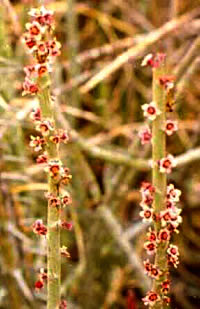
Small yellow-red flowers emerge periodically
on the pencil-like candelilla stalks in spring and summer,
apparently in response to rains. Photo by Glenn Evans,
courtesy of the Texas Memorial Museum.
|
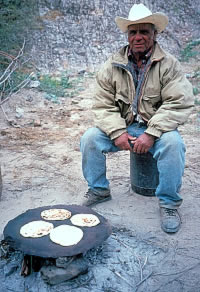
Rising early for the day's work,
Dimitrio Diez cooks a breakfast of tortillas on a make-shift
griddle. Photo by Raymond Skiles. Click to enlarge.
|
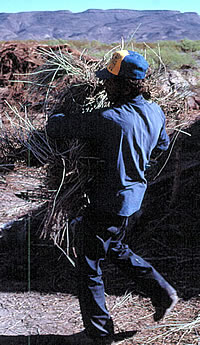
Strong arms and a sturdy back. A
candelillero (or wax worker, "cerero") hauls
an enormous bundle of candelilla. The plants are typically
harvested entirely by hand, or with the aid of a sharpened
stick. Photo by Raymond Skiles. Click to enlarge.
|
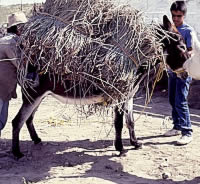
Workmen load a burro with bundles
of harvested candelilla. The animals haul the plant
stalks to the processing area, close to water and camp.
Photo by JoAnn Pospisil.
|
|
When asked how much candelilla can be carried by
each burro, one candelillero responded: "That depends
entirely on the conscience of the man-one man may put
250 or even 300 pounds on a burro, while another man
will never put over 150 pounds on his animals."
|
|
